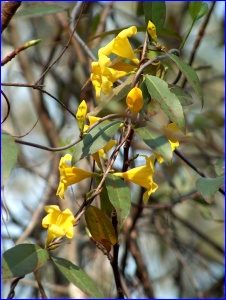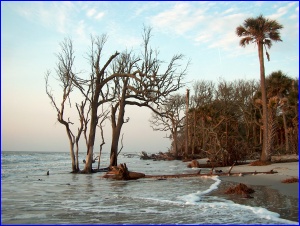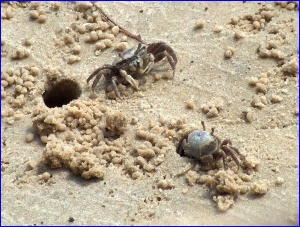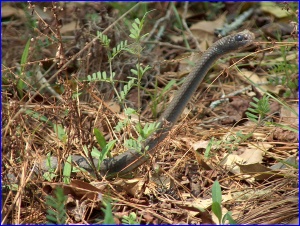

|
|
| « Previous | Next » |
South Carolina Spring |
Wednesday, 31 March 2004 |
| written by Teresa |
 The sweet fragrance of Yellow Jessamine drifts in the air attracting bees, its delicate flowers decorating the hedgerows, the vine scrambling upwards in search of an open sunny aspect, heralding the arrival of spring here in South Carolina. The heavy purple blooms of Wisteria provide a perfect companion, their flower heads drooping in characteristic appearance of weariness, creating large splashes of colour, covering trees and bushes in their exuberance. The fresh delicate greens of burgeoning foliage lightly cover the skeletal trees, leaves still soft and clean in these early weeks of the growing season. The pinks and whites of blossom trees vie for the bee's attention while the azaleas have already started their takeover bid, intent on shaming all other contenders with their showy display.
The sweet fragrance of Yellow Jessamine drifts in the air attracting bees, its delicate flowers decorating the hedgerows, the vine scrambling upwards in search of an open sunny aspect, heralding the arrival of spring here in South Carolina. The heavy purple blooms of Wisteria provide a perfect companion, their flower heads drooping in characteristic appearance of weariness, creating large splashes of colour, covering trees and bushes in their exuberance. The fresh delicate greens of burgeoning foliage lightly cover the skeletal trees, leaves still soft and clean in these early weeks of the growing season. The pinks and whites of blossom trees vie for the bee's attention while the azaleas have already started their takeover bid, intent on shaming all other contenders with their showy display.
The coast still entices us and at Hunting Island the unremitting advance of the ocean is in evidence. The sea is steadily eating away at this barrier island, the beach disappearing at the startling rate of fifteen feet a year, the mature forest falling under the attack, the campground decidedly threatened.
 At low tide a wide flat expanse of sand stretches out. Willets and gulls scurry back and forth at the waters edge, their little foot stamping dances uncovering the morsels on which they feed. At high tide the beach becomes impassable, the water engulfing the edges of the island undermining outlying trees that eventually die and topple. The history of the islands lighthouse provides an excellent illustration of what is involved here. Built in 1875, it had to be moved a mile inland not fourteen years later, due to the onslaught of the sea. Luckily such an eventuality had been anticipated and the construction was of large cast iron plates that could be dismantled and reassembled. Today's efforts at conserving the island are dependent on massive funding that has not yet been secured and while on one level it's easy to understand the desire to preserve this lovely stretch of shore it's also possible to view it as an attempt to hold back the forces of nature that inevitably change the outline of the coast.
At low tide a wide flat expanse of sand stretches out. Willets and gulls scurry back and forth at the waters edge, their little foot stamping dances uncovering the morsels on which they feed. At high tide the beach becomes impassable, the water engulfing the edges of the island undermining outlying trees that eventually die and topple. The history of the islands lighthouse provides an excellent illustration of what is involved here. Built in 1875, it had to be moved a mile inland not fourteen years later, due to the onslaught of the sea. Luckily such an eventuality had been anticipated and the construction was of large cast iron plates that could be dismantled and reassembled. Today's efforts at conserving the island are dependent on massive funding that has not yet been secured and while on one level it's easy to understand the desire to preserve this lovely stretch of shore it's also possible to view it as an attempt to hold back the forces of nature that inevitably change the outline of the coast.
Having said that, the gentle pink light of sunrise illuminating the fallen trees and lapping water, does bring up a feeling of wanting to capture this for all time, to preserve it in some way. The beach is deserted, the air still cool, the only sound, the water in it's never ending movement, the occasional call of a bird. Natural beauty and peacefulness combine in one of those rare moments of perfection.
 Just inland, a colony of minute Fiddler Crabs freezes in mid-movement as we approach the edge of the lagoon. The ground is pitted with dozens of small holes; tiny balls of sand, debris from the excavation lie littered around. Crabs pose in a still life montage, caught outside the protection of their homes not sure whether we might represent a threat; sight and smell unable to differentiate between heron and human. After a few minutes they cautiously return to the business of the day, the slight blue of their carapace obvious as the sun comes out, the males posturing with their oversized front claw. Mesmerised by this Lilliputian crab world, we watch the comings and goings for some time, occasionally sending them back into their statuesque state with an inadvertent movement.
Just inland, a colony of minute Fiddler Crabs freezes in mid-movement as we approach the edge of the lagoon. The ground is pitted with dozens of small holes; tiny balls of sand, debris from the excavation lie littered around. Crabs pose in a still life montage, caught outside the protection of their homes not sure whether we might represent a threat; sight and smell unable to differentiate between heron and human. After a few minutes they cautiously return to the business of the day, the slight blue of their carapace obvious as the sun comes out, the males posturing with their oversized front claw. Mesmerised by this Lilliputian crab world, we watch the comings and goings for some time, occasionally sending them back into their statuesque state with an inadvertent movement.
North along the coast we come to Edisto Beach where the sand is covered in piles of shell. Collecting seems to be a major pastime among the campers, the spoils of their days work displayed on picnic tables, the larger conch shells going for as much as twenty five cents. The beach here slopes upwards before dropping off into the salt marsh behind. By May, these higher banks of sand will attract Loggerhead Turtles looking for nesting sites but unfortunately we'll be long gone by then.
A trail through the coastal woodland again highlighted our hankering for some gradient. We have seen nothing resembling a hill for well over two months and it's beginning to get to us. Daydreams of mountains and open skylines are never far away but in the meanwhile we have the closed-in dense woods, bordering on the ever-present grassy salt marshes.
 It was here that we first got a hint that snake season was beginning. Not looking where I was going, I very narrowly missed squashing a small bright green snake; off he shot into the undergrowth and defied our attempts to capture him on the camera. But he was only the first of many sightings over the ensuing weeks and other species, whilst less dramatically coloured, proved to be more photogenic.
It was here that we first got a hint that snake season was beginning. Not looking where I was going, I very narrowly missed squashing a small bright green snake; off he shot into the undergrowth and defied our attempts to capture him on the camera. But he was only the first of many sightings over the ensuing weeks and other species, whilst less dramatically coloured, proved to be more photogenic.
Both the quality and availability of drinking water is of great importance when your house is not permanently plumbed into the mains and Edisto Beach let us down on both counts. The water was so salty as to make you thirsty and the day we left, there was none of it to be had; allegedly because a telephone company doing work in the area had cut the pipe bringing water into the state park. Under normal circumstances this would not be a problem but the only source of water at our next stop, out in the national forest was a hand pump, dispensing brown, iron-tasting water. We made many trips back and forward with our various water containers before we had the tank full, the good news being that the two strange tastes somehow balanced each other out a little, the resulting mix being more or less drinkable. Now admittedly this doesn't happen very often but when it does it makes me grateful for the good water we find and reminds me of those throughout the world who walk miles a day to carry water that isn't truly fit for human consumption. A little salt mixed with some iron doesn't seem so bad after all.
| « Previous | [ Photos ] | [ Map ] | Next » |
Do you know someone who would enjoy this article? Click to e-mail it to them!
| Home | Log | Notes | Maps | Contact | Store |